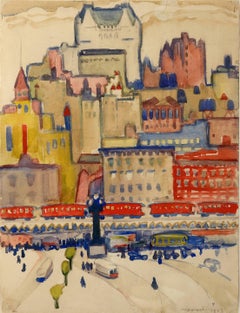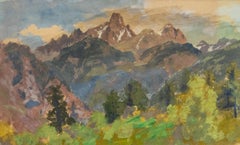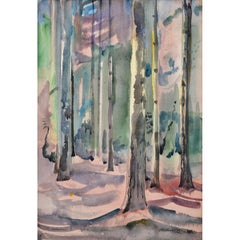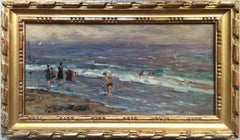William Zorach Landscape Paintings
American, 1887-1966
Born in 1887, by 1930, he was one of America’s premier 20th century sculptors and was honored with multiple commissions and exhibitions including at the Art Institute of Chicago, the Dallas Museum of Fine Art, the Whitney Museum of American Art, and numerous others.
He studied in New York City at the National Academy of Design and also in Paris under the mentoring of Jacques-Emile Blanche. It was in Paris in the first decade of the 20th century where Zorach’s path crossed with Marguerite, his soon to be wife. Both Marguerite and William were both represented in the landmark Armory Show of 1913.
William continued to paint for the next two decades, but increasingly experimenting with sculpture. By the mid 20’s he was carving significant works in marble and stone. By the early 30’s, he abandoned painting entirely in favor of a new art form, sculpture. I t was in sculpture that Zorach found his true voice as an artist and achieved considerable success. “Sculpture, direct carving, was an expanding universe, a liberation and a natural form of expression to me.” Zorach stated.
Museum Collections:
Amon Carter Museum of American Art
Arizona State University Art Museum
Boca Raton Museum of Art
Butler Institute of American Art
Cleveland Artists Foundation
Colorado Springs Fine Arts Center
Cornish Colony Museum
Dallas Museum of Art
Delaware Art Museum
Edwin a Ulrich Museum of Art
Farnsworth Art Museum
Flint Institute of Arts
Frederick R Weisman Art Museum
Georgia Museum of Art
Herbert F Johnson Museum of Art
Jack S Blanton Museum of Art
LaSalle University Art Museum
Los Angeles County Museum of Art
Lowe Art Museum
Marion Koogler McNay Art Museum
Memorial Art Gallery
Metropolitan Museum of Art, NYC
Middlebury College Museum of Art
Minneapolis Institute of Arts
Mobile Museum of Art
Museum of Fine Art-Boston
Pennsylvania Academy of the Fine Arts
Portland Museum of Art
Smithsonian Museum of Art
The Brooklyn Museum of Art
The Canton Museum of Art
The Columbus Museum of Art-Ohio
The Columbus Museum-Georgia
The Cummer Museum Of Art & Gardens
The Currier Museum of Art
The Nelson-Atkins Museum of Art
The Newark Museum
The Phillips Collection
The Phillips Museum of Art
The University of Michigan Museum of Art
Whitney Museum of American Art
Worcester Art Museum
Yosemite Museum
to
1
Overall Width
to
Overall Height
to
1
1
1
1
1
1
1
1
1
10
678
605
307
232
1
Artist: William Zorach
Quebec City, Fauve Landscape
By William Zorach
Located in Miami, FL
Wonderful Fauve Landscape with blocky areas of punchy bold reds and yellows. This was done the same year of the Armory Show in which both William Zor...
Category
Early 20th Century Expressionist William Zorach Landscape Paintings
Materials
Watercolor
Related Items
19th C. American Impressionist Gouache of Colorado Mountains in Spring
By Charles Partridge Adams
Located in Denver, CO
This original circa 1910s plein air field study by renowned Colorado landscape artist Charles Partridge Adams captures the serene beauty of the Rocky Mountains in a masterful display...
Category
1910s American Impressionist William Zorach Landscape Paintings
Materials
Gouache
$1,880
H 13.75 in W 17.75 in D 0.75 in
Family Farm in France
Located in London, GB
'Family Farm in France', gouache on art paper, by Michel Debiève (circa 1970s). An extremely endearing depiction of a French family farm, the delight is...
Category
1970s Modern William Zorach Landscape Paintings
Materials
Paper, Gouache
French Fauvist Gouache of Sailing Boats in Port Under a Setting Sun.
Located in Cotignac, FR
Watercolour and gouache on paper of sailing boats at a quay side. The painting is signed bottom right but as yet undeciphered and dated 1945. Presented in a patinated wood custom fra...
Category
Mid-20th Century Expressionist William Zorach Landscape Paintings
Materials
Watercolor, Gouache, Paper
$765 Sale Price
20% Off
H 20.48 in W 22.84 in D 0.6 in
Contemporary impressionist seascape nature acrylic painting on paper
Located in VÉNISSIEUX, FR
This vibrant and evocative artwork "My sweet summer Provence " presents a picturesque seaside landscape, painted with bold strokes and a vivid color palette that instantly captivate...
Category
2010s Impressionist William Zorach Landscape Paintings
Materials
Paper, Acrylic, Watercolor
$471 Sale Price
30% Off
H 16.54 in W 11.62 in D 0.04 in
Contemporary impressionist landscape nature watercolor painting on paper
Located in VÉNISSIEUX, FR
This artwork "My love for Paul Cezanne" , inspired by Paul Cezanne, presents a vibrant and abstract interpretation of a tranquil landscape, characterized by energetic brushstrokes an...
Category
2010s Abstract Impressionist William Zorach Landscape Paintings
Materials
Paper, Watercolor
$289 Sale Price
30% Off
H 11.7 in W 8.27 in D 0.04 in
Notre Dame de Paris II
By Lucien Génin
Located in London, GB
'Notre Dame de Paris II', gouache on paper, by Lucien Génin (circa 1930s). One of two paintings of Notre Dame by this artist held by our gallery, it is also an absolutely charming and now, historic depiction from the 1930s, of the most famous cathedral in France. This version uses more exaggerated brushstrokes with strong colours attesting to its expressionist roots. Notre Dame is one of the most widely recognised symbols of the city of Paris and the French nation. As the cathedral of the Archdiocese of Paris, Notre-Dame contains the cathedra of the Archbishop of Paris. Approximately 12 million people visit Notre-Dame annually, making it the most visited monument in the city. While undergoing renovation and restoration, the roof of Notre-Dame caught fire on the evening of 15 April 2019. Burning for around 15 hours, the cathedral sustained serious damage. The government of France hopes the reconstruction can be completed by Spring 2024, in time for the opening of the 2024 Summer Olympics in Paris. Unlike the actual cathedral, this artwork is in good condition, is newly framed and glazed and signed by the artist in the lower right hand corner. Upon request a video may be provided.
About the Artist: After the devastation of the First World War, Lucien Génin (1894 - 1953) left his provincial home in the autumn of 1919 to find his fortune among the lively Parisians in the heart of Montmartre. Génin befriended the painters Frank Will, Gen Paul, Émile Boyer, Marcel Leprin...
Category
1930s Expressionist William Zorach Landscape Paintings
Materials
Paper, Gouache
Monywa II
By Than Aung
Located in London, GB
'Monywa II', watercolour on paper, (2003) by Burmese artist, Than Aung. Monywa is a region in Burma-Myanmar on the east bank of the River Chindwin. This...
Category
Early 2000s Contemporary William Zorach Landscape Paintings
Materials
Watercolor
'Les Alyscamps Arles' by Yves Brayer, Large Watercolour Painting
By Yves Brayer
Located in London, GB
'Les Alyscamps Arles', watercolour on art paper, by Yves Brayer (1977). This term has its origins and is related to the Elysian Fields, also called Elysium, which is the final restin...
Category
1970s William Zorach Landscape Paintings
Materials
Paper, Watercolor
$5,399
H 37.8 in W 46.07 in
Place Pigalle
By Lucien Génin
Located in London, GB
'Place Pigalle', oil and gouache on art paper, by Lucien Génin (circa 1930s). Pigalle is well known to tourists who want to experience "Paris by night". It is home to some of Paris' most famous cabarets such as the Moulin Rouge which was immortalised by artist Toulouse-Lautrec. Lautrec's studio was here as was Picasso's, Vincent Van Gogh's and that of Andre Breton. In 1928 Josephine Baker opened her first nightclub next door to Breton's apartment. It is certainly a historical landmark of Paris and well known to so many visitors of this beautiful city. Génin painted Paris and Parisians and this is another one of his charming works among many held by this gallery. Please feel free to peruse them all on this platform. In good overall condition. Newly framed and glazed with anti-reflective glass. Upon request a video may be provided.
About the Artist: After the devastation of the First World War, Lucien Génin (1894 - 1953) left his provincial home in the autumn of 1919 to find his fortune among the lively Parisians in the heart of Montmartre. Génin befriended the painters Frank Will, Gen Paul, Émile Boyer...
Category
1930s William Zorach Landscape Paintings
Materials
Paper, Oil, Gouache
Barge on the Seine River
By Roland Dubuc
Located in London, GB
'Barge on the River Seine', watercolour on paper, by Roland DuBuc (circa 1970s). The broad Parisian river Seine divides Paris into the left and right banks. This particular scene appears to be well down river beyond the city as the greenery along the banks points to. The Seine’s collection of lovely small towns happily graces its banks and proudly conveys French culture. Of course, the best way to experience all of these towns and villages is on a river cruise. The Seine is second only to the Loire River which is France's longest. It rises 18 miles (30 kilometres) northwest of Dijon and flows in a northwesterly direction through Paris before emptying into the English Channel at Le Havre. The artist Dubuc created many artworks with the Seine as backdrop. You can have this one right in your living room. In good overall condition, the piece is newly framed and glazed with anti-reflective glass. It is signed by the artist in the lower left hand. Upon request a video of the painting may be provided.
About the Artist: Roland DuBuc (1924-1998), French artist, the sixth of 13 children and son of a construction worker. The very precariousness of the family's financial situation forced him to go to work at the age of 14. In extreme poverty, he moved to Rouen where he was lodged by the Salvation Army. During that time he struck up friendships with several artists who gave him advice and taught him techniques of drawing. He moved to other cities later where he met painters including, among others, Fred Pailhès...
Category
1970s William Zorach Landscape Paintings
Materials
Paper, Watercolor
Contemporary impressionist landscape nature watercolor painting on paper
Located in VÉNISSIEUX, FR
This artwork "Magic place from my childhood" is a compelling landscape painting that captures the dynamic essence of nature through vigorous brushstrokes and a vivid color palette.
...
Category
2010s Impressionist William Zorach Landscape Paintings
Materials
Paper, Acrylic, Watercolor
$471 Sale Price
30% Off
H 11.62 in W 16.54 in D 0.04 in
Jurassic Cliffs Dorset Coast 1970s British Watercolour Landscape Painting
Located in Cirencester, Gloucestershire
Title: Jurassic Cliffs Dorset Coast 1970s British Watercolour Landscape Painting
by John Steane (b.1931)
Size: 15.5 inches (height) x 23 inches (width)
watercolor painting on paper, ...
Category
Late 20th Century Impressionist William Zorach Landscape Paintings
Materials
Watercolor
Previously Available Items
William Zorach Watercolor Painting, Forest Landscape
By William Zorach
Located in Lake Worth Beach, FL
Artist/Designer; Manufacturer: William Zorach (American, 1887-1966)
Marking(s); notes: signed, marking(s); 1942
Materials: watercolor on paper
Dimensions (H, W, D): 22"h, 15"w; 33"h,...
Category
20th Century William Zorach Landscape Paintings
Materials
Watercolor
"Beach Day"
By William Zorach
Located in Southampton, NY
This is a very early painting by William Zorach done mostly likely when he was a student at the National Academy of Design in 1910 in New York. It is done in an impressionist style w...
Category
Early 1900s American Impressionist William Zorach Landscape Paintings
Materials
Oil, Board
Winter Day Along the Kennebec
By William Zorach
Located in Wiscasset, ME
Painter, sculptor and writer William Zorach was born in Lithuania in 1889 but moved to the United States with his family in 1893, settling in Cleveland. Zorach stayed in Ohio for al...
Category
1930s Modern William Zorach Landscape Paintings
Materials
Watercolor
William Zorach landscape paintings for sale on 1stDibs.
Find a wide variety of authentic William Zorach landscape paintings available for sale on 1stDibs. You can also browse by medium to find art by William Zorach in paint, board, oil paint and more. Much of the original work by this artist or collective was created during the 20th century and is mostly associated with the Impressionist style. Not every interior allows for large William Zorach landscape paintings, so small editions measuring 10 inches across are available. Customers who are interested in this artist might also find the work of Wilson Henry Irvine, Anthony Thieme, and William Lester Stevens. William Zorach landscape paintings prices can differ depending upon medium, time period and other attributes. On 1stDibs, the price for these items starts at $7,200 and tops out at $45,000, while the average work can sell for $26,100.



